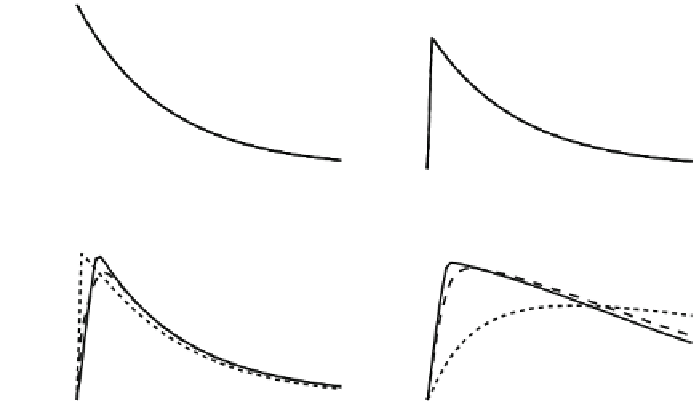Biomedical Engineering Reference
In-Depth Information
a
b
100
0.5
t
1
= 10 hours
t
1
= 100 hours
t
1
= 1000 hours
0.4
0.3
50
0.2
0.1
0
0
0
1
2
3
4
0
1
2
3
4
time (weeks)
time (weeks)
c
d
0.02
0.2
0.015
0.15
0.01
0.1
0.005
0.05
0
0
0
1
2
3
4
0
1
2
3
4
time (weeks)
time (weeks)
Fig. 5
Sensitivity analysis of the phase-changemodel in both layerswith respect to the characteristic
drug unbinding time scale
t
1
. Temporal evolution of
a
the solid-phase drug concentration
c
e
;
b
the
liquid-phase drug concentration
c
0
;
c
the free drug concentration
c
1
;
d
the bound drug concentration
c
b
, each time averaged over the entirety of their respective layers. In panels
a
and
b
all three curves
coincide since the time scale change in the medial layer does not feed back into the polymer layer
faster drug binding/unbinding kinetics. At the same time, the free drug concentration
in the wall is barely affected by changes in the drug binding/unbinding kinetics.
On the other hand, if we assume a single liquid-phase
c
0
in the coating, we can
control the drug release kinetics by setting the drug diffusivity
D
0
. Using Higuchi's
formula, we can estimate the characteristic release time of the drug from the polymer
l
0
ˀ
as
t
e
4
D
0
[
18
]. Figure
6
a demonstrates how using a single-phase model and
varying the characteristic release time
t
e
(and with that the diffusivity
D
0
) can in
fact be used to approximate the release profiles obtained with the two-phase model
varying the solid-liquid transfer time. This leads to very similar bound drug dynamics
in the wall (Fig.
6
b). These results indicate that a single-phase model in the coating
can be used to describe the (averaged) release dynamics and leads to a very similar
(averaged) response in the wall. However, from a designer's point of view, the more
detailed information about the solid-fluid transfer time and the porosity might be
more valuable and easier to control.
Moreover, the current simulations show that, although an additional equation
needs to be solved, the proposed two-phase model in the coating is significantly
simpler to handle numerically, at least in the one-dimensional case. The reason for this
lies in the otherwise very steep concentration gradient at the coating-wall interface.
The steep gradient requires a significantly larger number of elements and smaller
=

















































































































































































































































